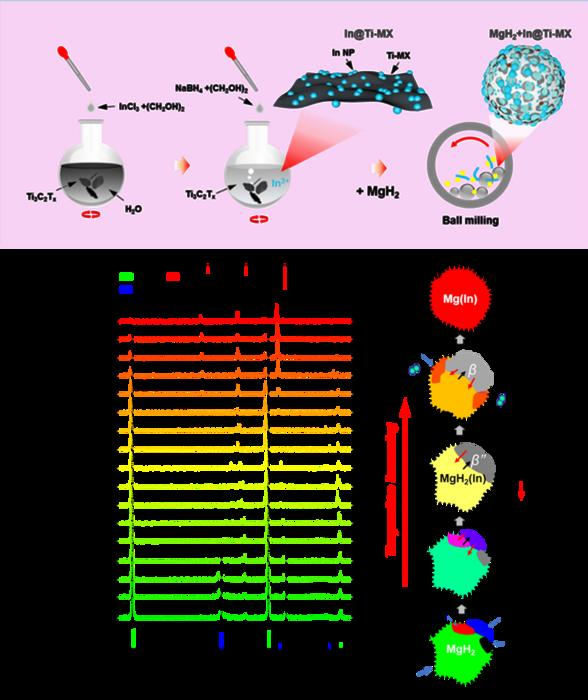MgH2's potential for practical hydrogen storage hinges on unlocking both fast hydrogen uptake and release (kinetics) and energy efficiency (thermodynamics). This study tackles this challenge by introducing a novel nanocomposite, In@Ti-MX, into MgH2.
 The schematic synthesis process of MgH2+ In@Ti-Mx, and in-situ He-Xrd patterns for the hydrogenated MgH2+25 Wt%In@Ti-Mx composites under a continuous heating and the corresponding schematic illustration of the proposed mechanism for the dehydrogenation. Image Credit: Wen Zhu, Shanghai Jiao Tong University
The schematic synthesis process of MgH2+ In@Ti-Mx, and in-situ He-Xrd patterns for the hydrogenated MgH2+25 Wt%In@Ti-Mx composites under a continuous heating and the corresponding schematic illustration of the proposed mechanism for the dehydrogenation. Image Credit: Wen Zhu, Shanghai Jiao Tong University
Economic, efficient, and safe hydrogen storage methods play a crucial role in exploiting hydrogen energy, reducing carbon emissions, and improving the utilization efficiency of renewable clean energies.
Jianxin Zou, Study Author and Professor, National Engineering Research Center, Light Alloys Net Forming & State Key Laboratory of Metal Matrix Composites, Shanghai Jiao Tong University
Jianxin Zou continues, “Solid-state hydrogen storage in hydrides has been considered as a promising hydrogen storage technology. Although the industrial application of solid-state hydrogen storage technologies with metal hydride is still in the stage of an attack.”
Take Magnesium-based hydrides as an example, Magnesium is the eighth most abundant element in Earth’s crust, and low-cost, with excellent operation safety and environmentally friendly.
Jianxin Zou, Study Author and Professor, National Engineering Research Center, Light Alloys Net Forming & State Key Laboratory of Metal Matrix Composites, Shanghai Jiao Tong University
Zou adds, “Magnesium-based hydrides are attractive candidates for large-scale hydrogen energy storage systems due to their high hydrogen storage densities, good cyclic performance, and high abundance of Mg on earth. The implementation of MgH2 as a hydrogen-storage medium has long been restricted by two dominating intrinsic challenges.”
Zou explained that the initial hindrance is the high thermodynamic stability (ΔH = 74.7 kJ mol−1 H2) resulting in the high decomposition temperature of MgH2. Another obstacle is the rather sluggish hydrogen ab/de-sorption kinetics originating from a high H2 dissociation energy barrier, and slow hydrogen diffusion rate in MgH2 bulk.
Numerous attempts have been undertaken, including catalyst doping, nano-crystallization, alloying, and destabilization, to enhance the MgH2/Mg hydrogen storage performance. Additionally, dual control over MgH2’s thermodynamics and kinetics is necessary for real-world applications.
Prior research demonstrated that the addition of catalysts to Mg/MgH2 could significantly speed up the kinetics of hydrogen de-/absorption. MXenes-based catalysts, out of all the catalytic compounds, have garnered a lot of interest because of their distinct two-dimensional structure and component tunability.
The majority of MXenes-based catalysts, including Ti3C2 MXenes and Ni@Ti-MX, are unable to change the thermal stability of MgH2/Mg, though, which led to a high desorption temperature at 1 bar hydrogen pressure and intricate heat management procedures for real-world applications. This is similar to other common catalysts.
One popular method for enhancing the kinetic and thermodynamic characteristics of magnesium-based hydrogen storage materials is alloying. It is noteworthy that MgH2’s thermodynamics can be enhanced with solid solution alloys without suffering a sizable capacity loss. It has been demonstrated that indium, cadmium, silver, etc can destabilize the thermodynamics of MgH2 by forming a solution with Mg.
As In is highly soluble in magnesium (up to 10 at%), the Mg-In system shows the greatest thermodynamic improvement. Zou and his group examined the most recent studies, contrasting the improvements in the kinetics and thermodynamics of earlier studies to determine the strategies and areas on which future research should concentrate.
MXene not only possesses excellent catalytic effects, but also provides nanoconfinement ability via its two-dimensional layered structure, which can effectively improve both the kinetic property and the cycling stability of the Mg based composites. On the other hand, In alloying has been demonstrated to be an efficient way to achieve thermodynamic destabilization of the Mg/MgH2 system. In this paper, we aim to combine the advantages of MXenes and Mg(In) solid solution in the modification of MgH2/Mg to simultaneously alter the thermodynamics and kinetics of Mg-based hydrogen storage materials.
Jianxin Zou, Study Author and Professor, National Engineering Research Center, Light Alloys Net Forming & State Key Laboratory of Metal Matrix Composites, Shanghai Jiao Tong University
Zou says, “Results showed that both the thermodynamics and kinetics of Mg-In-Ti hydrogen storage system have been optimized. The enhanced de/hydrogenation properties of MgH2 catalyzed by In@Ti-MX and corresponding mechanisms have been systematically probed and elaborated.”
It is important to note that the Mg-In-Ti hydrogen storage system’s kinetic and thermodynamic properties are still far short of what is needed for on-board applications. The commercial production and real-world application of such fascinating materials are still far off. As Zou pointed out, the goal of the upcoming research is still to break through the operating temperature barrier.
Zou concludes, “Although MgH2 has been extensively studied as one of the most promising solid-state hydrogen storage materials, its application in other energy fields has attracted little attention. Considering the low cost and unique phase transformation behavior, we expect to see a surge in the application of nanostructured Mg-based hydrogen storage materials in various energy fields, such as energy storage of renewable energy.”
Jianxin Zou is also affiliated with the Shanghai Engineering Research Center of Mg Materials and Applications & School of Materials Science and Engineering, and Shanghai Key Laboratory of Hydrogen Science & Center of Hydrogen Science, Shanghai Jiao Tong University. Other contributors include Wen Zhu, Li Ren, Yinghui Li, Chong Lu, Xi Lin, Qiuyu Zhang, Xue Yang, Zhigang Hu, Tao Cheng, and Yingyan Zhao.
The following authors have additional affiliations: Xue Yang and Tao Cheng, Sinopec Research Institute of Petroleum Processing Co., LTD.
The National Key R&D Program of China and the National Natural Science Foundation supported the study.
Journal Reference:
Zhu, W., et al. (2023). In situ High-Energy Synchrotron X-ray Studies in Thermodynamics of Mg-In-Ti Hydrogen Storage System. Energy Material Advances. doi/10.34133/energymatadv.0069